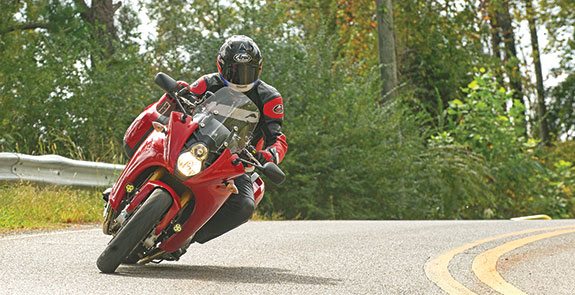
(Photography by Phil Hawkins)
The first American four-cylinder street bike in the 70 years since World War II has now reached production, and the initial examples of the V-4 Motus MST and higher-performance MST-R sport tourers have been delivered to the first of the more than 270 customers who’ve placed deposits with the start-up company based in Birmingham, Alabama. They have lined-up to buy a bike whose patient development since 2008 has resulted in a unique motorcycle that is all-American in every way—and without being a V-twin.
There’s nothing on wheels more typically American than a lazy-revving, large displacement V-8 motor, as attested by the hundreds of millions of vehicles built by GM, Ford and Chrysler over the past century powered by such engines. Though manufacturers from other continents long ago discarded this simple-is-best mechanical mantra in favor of smaller-capacity, overhead-cam, multi-valve motors with a greater appetite for revs, U.S. auto makers have refined the humble OHV pushrod powerplant to the extent that it’s now capable of delivering serious horsepower very reliably, as a look at any NASCAR race, or indeed the Le Mans 24 Hours, will prove. Contrary to what some seduced by spec sheets may think, there’s nothing low rent about using pushrods, or sticking with OHV rather than OHC, so long as you do it right—and Detroit’s engineers are past masters at this, as the men making the Motus sport tourers (hence MST) aim to prove.

The MV4 1,650cc OHV V-4 Baby Block motor powering the Motus, with pushrod actuation of the two valves per cylinder, was conceived as one half of a typical Detroit-built V-8, duly downsized. It was originally developed in the Motor City by auto engine R&D specialist Katech Inc., employing the best design features of its GT1 Le Mans-winning Chevrolet Corvette LS7.R small-block V-8 pushrod motor, which is still winning races today. After Motus Motorcycles owners Lee Conn, 42, and Brian Case, 37, founded their company in 2008, they inked a deal with Katech to develop a motor to power the Motown motorcycle they’d decided to create to plug the gap in the marketplace they’d perceived as existing for an American-built sport tourer.
Having enlisted Katech to develop a pushrod V-4 motor, the two partners went looking for someone to help them create the motorcycle to house it. In 2009 they signed up Pratt & Miller, another Detroit-based engineering company with broad high-tech R&D capability. Although Case conceived the Motus platform to house the MV4 motor, with the crank running lengthways in the chassis Guzzi/Honda ST1300/BMW boxer-style, he’s relied on Pratt & Miller to translate that into a production package via rigorous development of the chassis design, as well as the 6-speed transmission with chain final drive, which P&M designed to bolt onto the Katech-built motor. “We would have been selling these bikes three years ago if we’d bought an off-the-shelf engine and transmission package from Rotax, or a V-twin S&S motor like everyone else,” says Case.
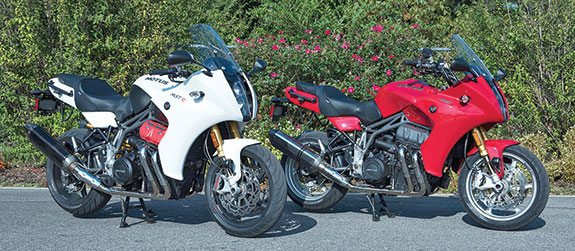
His responsibility for the Motus platform extended to taking care of the styling, in which the V-4 engine naturally plays an important visual role. After putting several thousand miles under the two proof-of-concept motorcycles they’d constructed by 2011, and allowing me to become the first journalist to test ride them three years ago, the two partners knew what they needed to change for production—and it was quite an extensive list, resulting in a total redesign of the V-4 motor to the point that, other than general architecture, the production MV4 engine shares literally zero components with the prototypes. “We were happy with what we’d achieved, but had several improvements to make, plus things we had to alter to get the cost down, to make it affordable to produce the motor in volume,” says Case. “So we totally redesigned it to incorporate these.”
That redesign entailed switching from the prototypes’ efficient and groundbreaking but costly gasoline direct injection (GDI), removing the twin counterbalancers, subtly altering the engine’s bore and stroke measurements, improving the cylinder head design and especially the porting, finding a new American supplier in nearby Oklahoma to develop a dedicated electronics package to replace the off-the-shelf Magneti Marelli system, and improving performance of the MST-R. This uses the same engine platform as the MST, but has a high-lift cam for more duration, revised engine mapping and a 400-rpm higher rev limiter than the MST’s 8,200-rpm redline, thanks to which it delivers 180 horsepower at 7,800 rpm at the crankshaft (165 on the MST) with 126 lb-ft of torque at 5,000 rpm (MST 123 lb-ft). Prices start at $30,975 for the MST, running to $36,975 for the MST-R, with a choice of three different colors for each model, and including a two-year unlimited mileage warranty.

Over the past three years, while finalizing development of the production model, the partners established a 12,000-square-foot factory in the same downtown Birmingham building that once housed the Barber motorcycle collection before it moved to its present purpose-built location. The aim is to construct 250 bikes this year, building up to 1,000 bikes annually within three years, especially once the company begins exporting sometime in 2016, says Conn. All the 20-plus Motus dealers so far recruited in the USA will have to offer test rides, by the way.
The chance to ride the production version of the Motus in both MST and uprated MST-R guise came in late fall 2014 along the superb roads of Alabama’s hill country as well as the streets of Birmingham. I spent most of my time over the three days on a red base-model MST, fitted with the good-looking twin Givi panniers included as standard (with an optional 30-liter top box available). These are claimed to each be able to hold a full-face helmet, and are wide enough to prevent lane splitting in traffic with any confidence. Climbing aboard revealed an extremely comfortable riding stance that you can precisely tailor to suit your tastes and stature via the finest multi-adjustable triple-axis handlebar package I’ve yet encountered on any motorcycle, even a BMW, with a five-inch adjustment up, down, fore and aft, and you can adjust the wrist angle over a 15-degree span, too. It’s made by Maine-based HeliBars, and it’s perfect.
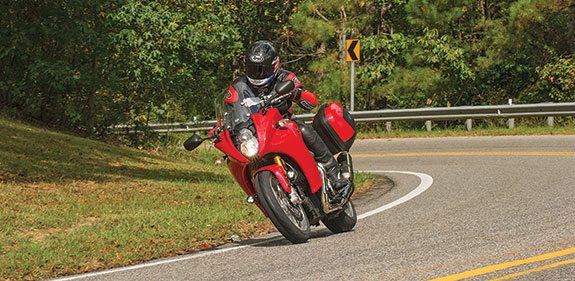
Also adjustable is the Motus’ windscreen, which has a choice of four positions and can be raised a maximum of 3 inches from its lowest setting, over a 5-degree angle. I used the middle setting, and found myself cocooned in still air travelling at 85 mph, with zero buffeting. And yes, that is indeed a KTM headlight on the bike, in case you thought it looked familiar. Together with the twin spotlights available as options, the Motus light package gave outstanding high-speed illumination on a twilight ride back to Birmingham. The mirrors are benchmark kit, too—you can see clearly behind you without moving your shoulders. And the horn has a deep and mellifluous note that sounds like a freight train. Coming through!
The Sargent seat is now very comfortable, with the improved padding since the last time I rode the Motus giving good support, plus it’s narrow where it meets the fuel tank, making it easy for a 5-foot, 10-inch rider to put both feet flat on the ground. The tank is well shaped, so your knees tuck in easily to the flanks, avoiding contact with the cylinder heads thanks to the motor being canted forward 15 degrees. Coupled with the quite low-set footrests and the 32.5-inch high seat (there’s a one-inch lower option as well), this delivers a relaxed and comfortable riding position with a relatively upright posture. The flip-up footrests’ height is not adjustable, but the toe pegs for the gear and brake levers are. Having said all that, I can’t see the point of fitting the wide 190/55 rear tire to the Motus, because you ground out the footrests without coming close to using all the rubber. Much better, I’d have thought, to fit a 180-section tire which will also make the steering lighter, even if it’s less of a visual design statement.
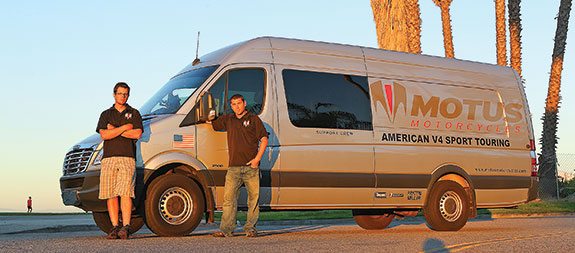
The Motus is undeniably unique in appearance—and in a good way, I hasten to add—with the red rocker covers on the MST-R’s V-4 motor representing engineering eye candy for those in search of a break from convention. But that’s nothing compared to what happens when you thumb the starter button, and the Murphy ECU’s excellent cold start mapping helps the engine instantly catch alight, and settle into a high 1,500-rpm idle. It’s the entry ticket to a concerto from one of the most unique engine notes in modern-day motorcycling. Sometimes the lilting burble from the twin exhausts makes the Motus MV4 engine sound like half-a-Chevy V-8, other times there’s a fruitier crack more like twin twins, as in double Ducatis—but first, last and always it’s totally distinctive, and extremely entertaining when heard from the hot seat.
Once in motion you don’t have to combat the sideways sway on the Motus that you usually get with any lengthways crank, like on a BMW boxer or Moto Guzzi. OK, blip the throttle in neutral, and the Motus will indeed rock from side to side—but only until you select a gear. The torque rotation of the lengthways crank is completely cancelled out by the perpendicular gearbox design. However, I’d been expecting that by eliminating the balance shafts, which had previously removed any trace of vibration from the V-4 engine, Motus would have restored at least a few vibes. Sorry, no—zilch, zero, no vibes of any kind until you start nearing the MST’s 8,200-rpm rev limiter (8,600 rpm on the MST-R), when a few gradually increasing tingles reach the footrests. So that really isn’t an issue, since it pays to use the bottom four ratios in the 6-speed transmission (fifth and sixth are overdrives, for relaxed high-speed cruising) to live in the MV4’s muscular happy zone between 4,000 and 7,000 rpm, surfing the serious waves of torque flowing from the motor in recognition of the half-a-Detroit V-8 it really is. Top gear roll-on is very good, making this a relaxing mile-eater in freeway travel.
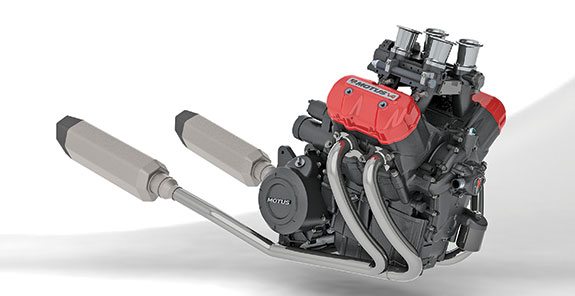
Equally well fixed is the clutch action on the Motus, which was previously very stiff. On the MST, this now has a light, easy pull—though it was just as stiff as before on the MST-R I also rode, because this was the actual bike fitted with beefed-up clutch springs on which Conn set an AMA land speed record of 165.81 mph in the 1,650cc P-PP (production pushrod, with AMA-supplied pump gas) class last September at the 2014 Bonneville Motorcycle Speed Trials, with Case recording 168.69 mph on an identical MST-R in the 1650cc P-PG class (open choice of pump gas). The two of them and their Motus crew then took turns riding the two completely stock bikes the 1,900 miles back to the Motus factory in Alabama in 30 hours, before breaking out the champagne. Those speeds at Bonneville (beating the previous Buell records by more than 20 mph) make the Motus MST-R the fastest production pushrod motorcycle in the world—ever.
Also improved is the gearshift action, no longer a little harsh like before, now lighter while invariably precise, with well-chosen gear ratios thanks to the ultra-torquey nature of the engine. The engine’s only turning 3,500 rpm at 85 mph in top gear, so less than halfway to redline according to the good-looking new full-color Murphy TFT (thin film transistor) instrument panel. It’s ultra legible in sunlight, with its main screen displaying a tach, digital speedo, mileage, twin trips, trip computer, fuel gauge, range and gear position, and then there’s an engine screen featuring such data as throttle position, water temp, oil pressure and the usual warning lights. There’s also a power port for plug-in accessories like GPS or a phone charger, with an extra two more available as options, and a stock 720-watt alternator powering a 60-amp charging system to operate them.
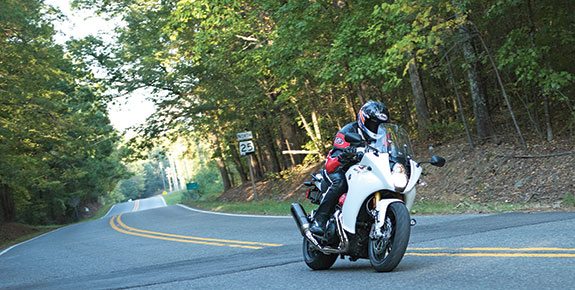
It was another pleasant surprise to remind myself how well the Motus handles, with a completely intuitive feel to the steering, which make you realize the chassis geometry has been well chosen and nicely refined. Again, it’s more sport than tourer, and the MST and MST-R find their way through a series of turns almost on autopilot, with huge feedback from the front tire via the well dialed-in Öhlins NIX30 fork. The Pilot 2 Michelins previously fitted have now been replaced for production by Pirelli Angel GT rubber, which I know from personal experience give good mileage in combination with excellent grip, plus they heat up fast. But I was particularly impressed by the Progressive Suspension rear shock on the MST, which while adjustable only for preload and rebound damping compared to the MST-R’s fully adjustable Öhlins TTX36 shock, delivered better damping over rough surfaces and a superior ride quality. The variable rate spring helped the Progressive shock live up to its maker’s name, with better compliance over real world road surfaces. OK, the Öhlins is better for sport riding—but I have to say that while the MST-R does have an extra top-end kick in performance, and its flatter Rizoma ’bar gives a sportier stance at the helm, I much preferred riding the less-costly MST. The R-model is a sportbike that you can fit luggage to, but the MST is a true sport tourer, a proper all-rounder of a motorcycle, and a very enjoyable real-world bike to ride.
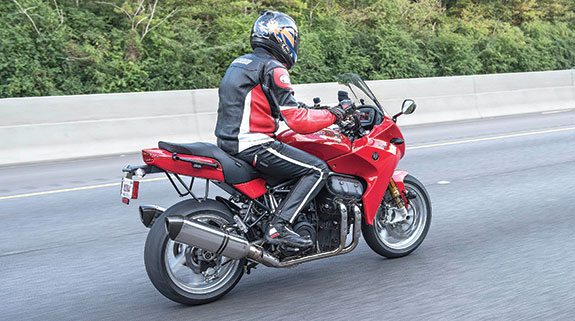
The Motus previously had too fierce a braking response at the first touch of the lever from the radial Brembo calipers gripping the 320mm discs, making you reluctant to use them too hard in the wet on a bike that’s obviously intended to be ridden in all weather conditions. That’s fixed on the MST via the two-piece Brembo calipers now fitted which are still mighty effective without being grabby. The MST-R still carries the Monoblocs in best sportbike mode, and you must therefore be ready for the fierce immediate response they deliver, for ABS is not yet available on the Motus. “We’re working on it, and plan to have it sometime next year,” says Conn. It’s needed. The sidestand is now easier to find than before, and a centerstand is included as standard—good thinking.
In fact, that says it all about the Motus package—the bikes aren’t cheap, but except for ABS they’re very fully spec’d and have very little left off them. The list of accessories is very short: a taller screen, lower seat, heated grips, heated seat, twin spotlights, a 30-liter top box and dual power ports. That’s it. Everything else is already included, plus the MST and MST-R have a unique engine design, invigorating performance, are extremely comfortable for long journeys, and are well finished judging by the build quality of the well-used pair I was riding. It’s also encouraging to find that the checklist of things to be improved or rectified that I left with them three years ago after riding the prototypes have all been attended to. Make no mistake about it; the Motus is a very serious and well-conceived attempt to service a segment in the marketplace that’s been mostly ignored by American manufacturers until now. The bikes were obviously developed by people who ride big distances themselves and know what they want—and need. Said Conn, “Motus is the Latin word for motion, but it can also mean a movement of like-minded people, which relates to how we got this thing started, and it has a connotation of a revolt against the accepted norm, which this bike certainly is!”
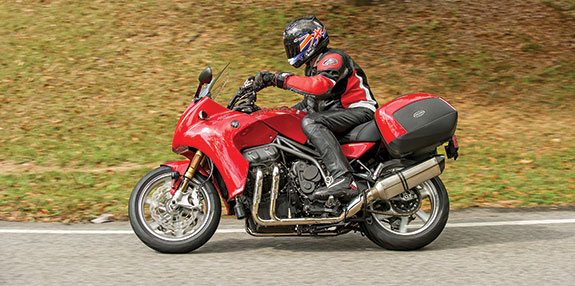
2015 Motus MST/MST-R
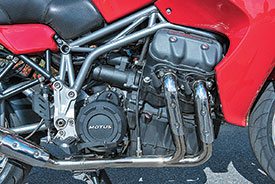
Warranty: 2 yrs., unltd. miles
Website: motusmotorcycles.com
Engine
Type: Liquid-cooled, longitudinal 90-degree V-4
Displacement: 1,650cc
Bore x Stroke: 88.0 x 67.8mm
Compression Ratio: 11.5:1
Valve Train: OHV w/ 4 valves per cyl., hydraulic lifters, roller-bearing rocker arms
Valve Insp. Interval: NA
Fuel Delivery: Multi-point EFI w/ 40mm throttle bodies x 4
Transmission: 6-speed w/ hydraulically actuated wet clutch
Final Drive: O-ring chain
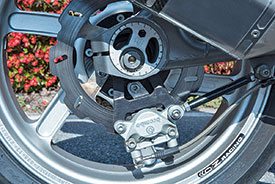
Frame: 4130 chrome-moly tubular-steel trellis space frame w/ tubular-steel swingarm
Wheelbase: 58.1 in.
Rake/Trail: 26 degrees/4.25 in.
Seat Height: 32.5 in.
Suspension, Front: 43mm Öhlins NIX30 inverted fork, fully adj. w/ 5.1-in. travel
Rear: Single PS shock, adj. for spring preload & rebound damping w/ 4.7-in. travel/Ohlins TTX36, fully adj.
Brakes, Front: Dual 320mm discs w/ opposed 4-piston radial calipers
Rear: Single 200mm disc w/ 2-piston pin-slide caliper
Wheels, Front: Forged/Carbon fiber, 3.50 x 17 in.
Rear: Forged/Carbon fiber, 6.00 x 17 in.
Tires, Front: 120/70-ZR17
Rear: 190/70-ZR17
Claimed Wet Weight: 580/565 lbs.
Performance
Fuel Capacity: 5.5 gals.
MPG: 91 PON min. (low/avg/high) NA
(This article Motown Motorcycle was published in the May 2015 issue of Rider magazine.)

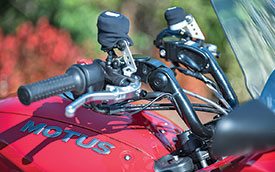
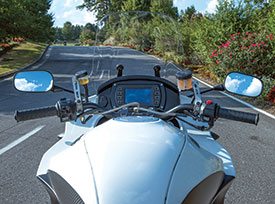
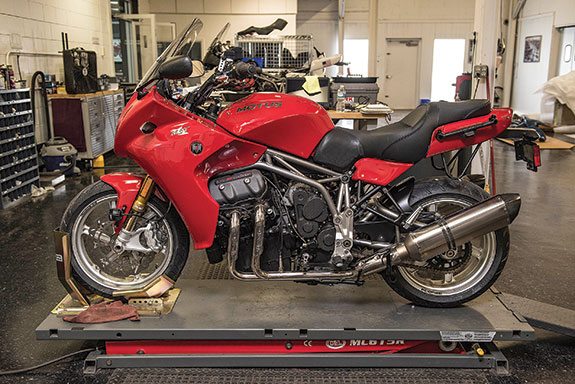







Over $30K and no ABS, with a chain drive? Hmm…
That’s EXACTLY the bike I’ve been waiting for! A comfortable American sportbike with what appears to be real character. Beautiful, too.
I would gladly sacrifice my right nut to own one. Sadly this is not going to happen any time soon, if at all, in the Netherlands (Europe).
So this is essentially a C7.R Corvette motorcycle seeing as the engine is half of the C7 and the Chasis design guys Pratt and Miller build…..you guessed it the C7.R
I was mildly interested until I saw the price ! That alone will kill this project.
really?
I have four Hondas … NC700, ST1300, CBR1000, Gold Wing
Altogether less $$$ than one of these machines, and I have a choice of riding style and KNOWN reliability
I’ll pass, though I respect what they’re producing
I have a 2004 R1150RT and a 2008 Buell Ulysses I will replace with this machine (the MST). Just a matter of when, not if.
Honda ST and Goldwing, BMW and Moto Guzzi with longitudinal engines use shaft drive, which only seems natural. Why the chain?
I just had the opportunity to test ride the Motus MST. A very impressive bike, but this review fails to mention the bucket of rocks sound the clutch and trans makes at idle. Honestly if I were to invest this much in a bike I would not want all my friends to be asking me what’s wrong with it. Other than that, great bike.